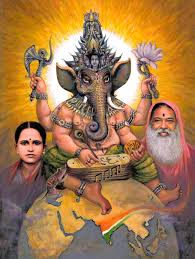The practice of according welcome to saints, emperors etc. with Purna kumbha has been in vogue since time immemorial.
What is Purnakumbha? It is a pot containing pure water, fresh twigs of five special plants, gem stones, fragrant substances etc. and is placed in a plate containing rice. A decorated coconut is placed at the top of the pot.
The twigs from the five special plants and the gem stones infuse healing properties into the water in the pot. The serene vibrations from this energized water will ensure that the peace emanating from the heart of the person being welcomed flows towards us.
The pot containing the sacred energized water represents our own body. The coconut placed at the top of the pot represents our head. Coconut is called a complete fruit (poorna phala). The outer shell represents the skull. The kernel represents the brain. The sweet water within the coconut represents the river of wisdom (jnana ganga). It was the conviction of our ancestors that the coconut, like the brain, represents fullness. The rice grains spread on the plate signify the land in which we live.
Our body remains ordinary until divine consciousness flows into it. By showing this Purnakumbha to saints, we are imploring them to instill divine consciousness into us.
In the ancient Indian tradition, kings were looked upon as Lord Vishnu. The kings too lived up to this. Due to this special status, they too were accorded welcome with a Purnakumbha.
Some are of the opinion that Purnakumbha should be accorded only during day time. This practice has its basis in the fact that the Prana energy (life-force) will flow easily in the presence of the Sun-god who is considered the source of Prana-energy.
Where we are unable to obtain the twigs of the five special plants, we can use the tender mango leaves or betel leaves. In lieu og gem stones we can use coloured rice (akshata).
(Bhaktimala June 1997)
